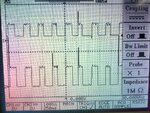hshah8970
Full Member level 2
Hello everyone.
I'm operating a DC motor through a PWM signal but I'm facing a problem regarding the back EMF generated by the DC motor.
Ideally, I want the back EMF eliminated.
Currently when I connect an oscilloscope across the motor, I find that the voltage across the motor never reaches zero. When the PWM waveform is LOW, the motor keeps on moving and we get a reading of the back EMF on the oscilloscope.
Is there any way in which I could minimize the back EMF such that the waveform across the motor resembles a normal HIGH-LOW PWM signal?
I'm attaching an image for your reference. The top waveform is what I observe across the motor. Note how it never reaches zero (zero is marked by the arrow labeled '1' on the left) whereas the applied waveform is shown under it which reaches zero like it should (arrow labeled '2' marks zero for that wave).
P.S. I will also appreciate suggestions to eliminate those voltage spikes.

I'm operating a DC motor through a PWM signal but I'm facing a problem regarding the back EMF generated by the DC motor.
Ideally, I want the back EMF eliminated.
Currently when I connect an oscilloscope across the motor, I find that the voltage across the motor never reaches zero. When the PWM waveform is LOW, the motor keeps on moving and we get a reading of the back EMF on the oscilloscope.
Is there any way in which I could minimize the back EMF such that the waveform across the motor resembles a normal HIGH-LOW PWM signal?
I'm attaching an image for your reference. The top waveform is what I observe across the motor. Note how it never reaches zero (zero is marked by the arrow labeled '1' on the left) whereas the applied waveform is shown under it which reaches zero like it should (arrow labeled '2' marks zero for that wave).
P.S. I will also appreciate suggestions to eliminate those voltage spikes.

![PWM Circuit - Multisim - [PWM Circuit ]_2012-09-02_17-15-06.png PWM Circuit - Multisim - [PWM Circuit ]_2012-09-02_17-15-06.png](https://www.edaboard.com/data/attachments/23/23363-1027975bf9654ca46c7c1c3ad497b52b.jpg)